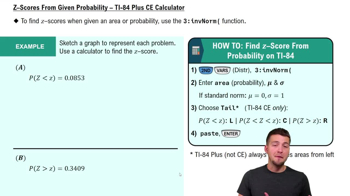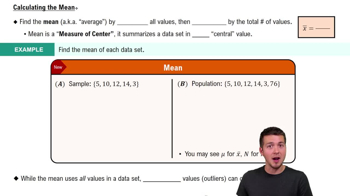Percentile Use the weights from Exercise 1 to find the percentile for 3647 mg.
Table of contents
- 1. Intro to Stats and Collecting Data1h 14m
- 2. Describing Data with Tables and Graphs1h 55m
- 3. Describing Data Numerically2h 5m
- 4. Probability2h 16m
- 5. Binomial Distribution & Discrete Random Variables3h 6m
- 6. Normal Distribution and Continuous Random Variables2h 11m
- 7. Sampling Distributions & Confidence Intervals: Mean3h 23m
- Sampling Distribution of the Sample Mean and Central Limit Theorem19m
- Distribution of Sample Mean - Excel23m
- Introduction to Confidence Intervals15m
- Confidence Intervals for Population Mean1h 18m
- Determining the Minimum Sample Size Required12m
- Finding Probabilities and T Critical Values - Excel28m
- Confidence Intervals for Population Means - Excel25m
- 8. Sampling Distributions & Confidence Intervals: Proportion1h 25m
- 9. Hypothesis Testing for One Sample3h 29m
- 10. Hypothesis Testing for Two Samples4h 50m
- Two Proportions1h 13m
- Two Proportions Hypothesis Test - Excel28m
- Two Means - Unknown, Unequal Variance1h 3m
- Two Means - Unknown Variances Hypothesis Test - Excel12m
- Two Means - Unknown, Equal Variance15m
- Two Means - Unknown, Equal Variances Hypothesis Test - Excel9m
- Two Means - Known Variance12m
- Two Means - Sigma Known Hypothesis Test - Excel21m
- Two Means - Matched Pairs (Dependent Samples)42m
- Matched Pairs Hypothesis Test - Excel12m
- 11. Correlation1h 6m
- 12. Regression1h 50m
- 13. Chi-Square Tests & Goodness of Fit1h 57m
- 14. ANOVA1h 57m
3. Describing Data Numerically
Standard Deviation
Problem 3.3.7b
Textbook Question
z Scores. In Exercises 5–8, express all z scores with two decimal places.
New York City Commute Time New York City commute times (minutes) are listed in Data Set 31 “Commute Times” in Appendix B. The 1000 times have a mean of 42.6 minutes and a standard deviation of 26.2 minutes. Consider the commute time of 95.0 minutes.
b. How many standard deviations is that [the difference found in part (a)]?
 Verified step by step guidance
Verified step by step guidance1
Step 1: Recall the formula for calculating a z-score: \( z = \frac{x - \mu}{\sigma} \), where \( x \) is the data value, \( \mu \) is the mean, and \( \sigma \) is the standard deviation.
Step 2: Identify the given values from the problem: \( x = 95.0 \), \( \mu = 42.6 \), and \( \sigma = 26.2 \).
Step 3: Substitute the values into the z-score formula: \( z = \frac{95.0 - 42.6}{26.2} \).
Step 4: Perform the subtraction in the numerator: \( 95.0 - 42.6 \). This gives the difference between the data value and the mean.
Step 5: Divide the result from Step 4 by the standard deviation \( \sigma = 26.2 \) to find the z-score, which represents how many standard deviations the data value is from the mean.
 Verified video answer for a similar problem:
Verified video answer for a similar problem:This video solution was recommended by our tutors as helpful for the problem above
Video duration:
4mPlay a video:
Was this helpful?
Key Concepts
Here are the essential concepts you must grasp in order to answer the question correctly.
Z-Score
A Z-score is a statistical measurement that describes a value's relationship to the mean of a group of values. It is calculated by subtracting the mean from the value and then dividing by the standard deviation. This standardization allows for comparison across different datasets by indicating how many standard deviations a data point is from the mean.
Recommended video:
Guided course

Z-Scores From Given Probability - TI-84 (CE) Calculator
Mean
The mean, or average, is a measure of central tendency that is calculated by summing all values in a dataset and dividing by the number of values. In the context of the commute times, the mean provides a baseline to understand the typical commute duration, which is essential for calculating Z-scores and assessing individual commute times relative to this average.
Recommended video:
Guided course

Calculating the Mean
Standard Deviation
Standard deviation is a statistic that quantifies the amount of variation or dispersion in a set of values. A low standard deviation indicates that the values tend to be close to the mean, while a high standard deviation indicates a wider spread. In this question, the standard deviation is crucial for determining how far the specific commute time of 95.0 minutes is from the mean in terms of standard deviations.
Recommended video:
Guided course

Calculating Standard Deviation

 8:45m
8:45mWatch next
Master Calculating Standard Deviation with a bite sized video explanation from Patrick
Start learningRelated Videos
Related Practice
Textbook Question
